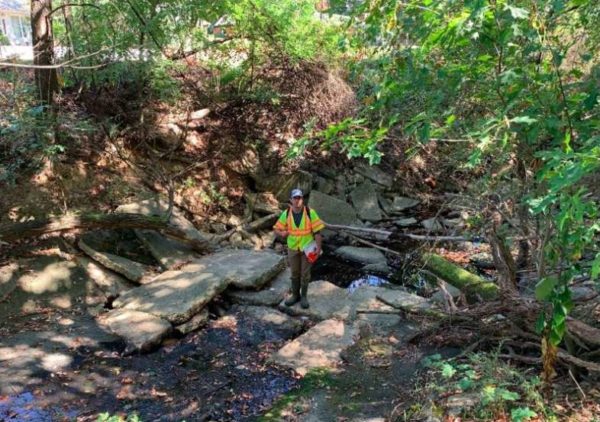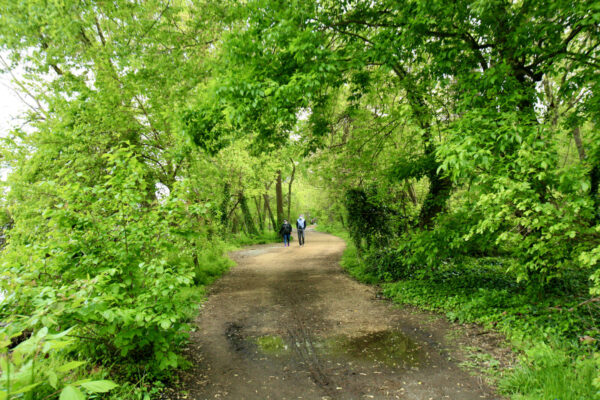Spilled paint could be seen in the waterways of Alexandria’s North Ridge neighborhood on Saturday.
That morning, the Alexandria Fire Department was alerted of a “white-cloudy substance in the waterways visible from the walking trail” near Monticello Park off Old Dominion Boulevard, according to an AFD press release.
Investigators determined the substance to be latex primer paint dumped in a storm drain. AFD canvassed the neighborhood for witnesses and determined the spill to be accidental.
“The area neighborhood was canvassed for witnesses and additional information,” the city said in a release. “The investigation determined the spill was accidental. Due to the nature of the substance, natural flushing of the waterway is the remediation approach. Water supply was not impacted.”
An investigation found the source of the paint to be a storm drain next to a home under renovation at the intersection of Crestwood Drive and Old Dominion Boulevard.
“An investigation done by the Hazardous Material team and the Fire Marshal’s Office (FMO) determined the source of the substance originated from a storm drain at the intersection of Crestwood Drive and Old Dominion Blvd,” the release said.
Paint was also dumped into Four Mile Run in Arlington in mid-July, although it ran down into Alexandria.
AFD encourages citizens to report environmental concerns by contacting Alex311 or reporting on the City’s website.
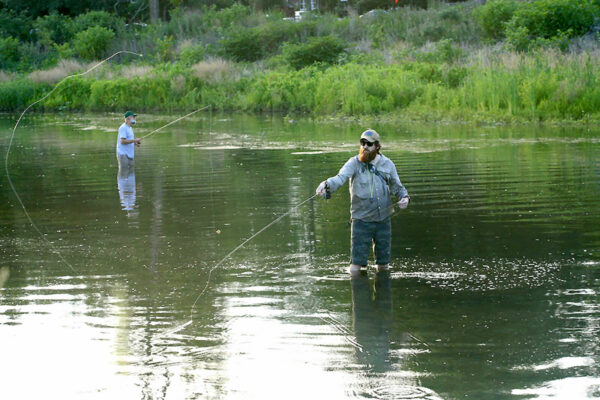
Alexandria is safe after a dumping incident in Four Mile Run in Arlington.
Arlington advised residents to stay out of stream runs along popular parks like Bluemont Park, Barcroft Park and the Shirlington dog park after a roll-off dumpster fell into a storm drain near N. Ohio Street, according to ARLnow.
“According to Arlington the discharge was from a roll-off dumpster at a single home construction site,” City spokesperson Camila Olivares said. “In the process of moving the dumpster, white liquid drained out into the right of way and nearby storm drain. They believe the product is likely paint.”
Olivares added, “Given the distance from the outfall to the County / City line, the plume will not be seen in Four Mile Run in Alexandria.”
Avoid Four Mile Run Stream downstream of N Ohio St for the next 48 to 72 hours. An advisory is issued following a dumping incident near I-66. Learn more about stream safety: https://t.co/6RVLSZI9kT. pic.twitter.com/PawpsSEhN3
— Arlington Department of Environmental Services (@ArlingtonDES) July 27, 2023
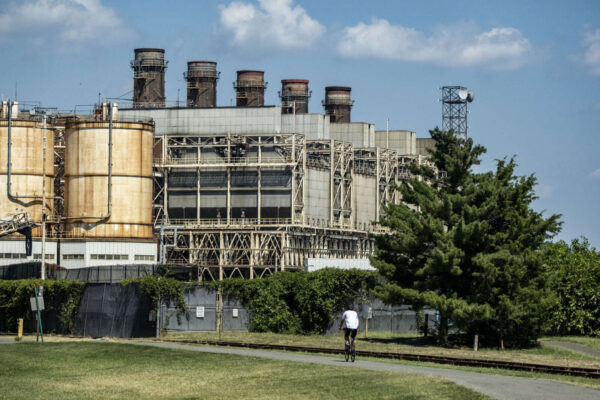
As developer Hilco Redevelopment Partners (HRP) heads into the ambitious redevelopment of the GenOn Power Plant, the developer laid out some of their plans for the complex process of breaking the site apart.
Representatives of the developer spoke last week to the Alexandria Local Emergency Planning Committee (LEPC) — full disclosure, this reporter is on the LEPC — about how the developers plans for abatement, remediation and deconstruction. The discussion was a follow-up to a previous LEPC meeting with Deputy Director for Infrastructure and Environmental Quality Bill Skrabak.
Mary Catherine Gibbs, land use counsel for HRP, said 2024 will likely be dominated by permit hearings for the project, with deconstruction and abatement starting in early 2025 — slightly later than the timeline laid out months ago.
The project is notable for the complexity of the environmental work that will go into making the former industrial plant a site safe for human habitation. Julianna Connolly is leading the remediation of the site and explained that remediation refers to anything on the ground level and below — like analyzing chemicals in the soil — while abatement refers to any of the environmental work above ground.
Connolly said there some of the sites of environmental contamination are already known.
“There’s an area on the site between the building and the river that had a known release from underground storage tanks,” Connolly said. “[They’re] still there, but closed.”
Connolly said the previous owner did remediation work to clean up the oil, but there’s still a residual impact on site that will need to be cleaned up.
Meanwhile, Connolly said her team has taken samples from across the site looking for more contamination — though the team hasn’t been able to sample under buildings yet. The early results, Connolly said, have been generally promising.
Metal content in the soil is generally below the standards set by the Virginia Department of Environmental Quality (Virginia DEQ). The main notes of concern in the soil samples are thallium, iron and manganese found above screening levels at a few locations. The screenings haven’t picked up polychlorinated biphenyls — a substance Connolly said is used to keep oil from lighting on fire — but she said it’s likely they’ll be found when her group checks closer to the transformers on-site.
Connolly said the next steps for her team are working through risk assessments for the site and developing a remediation plan.
“We already know we’re going to be working up near where the petroleum was, but we’re also identifying [other locations] on the site,” Connolly said. “We’re watching residual contamination very closely.”
For the above ground stuff, Nicholas Pullara, Vice President of development for HRP, said his team is combing through the site collecting regulated materials like asbestos, lightbulbs, electronic equipment and more.
“We’ve found asbestos, quite a bit of it, but it’s in good condition,” said Pullara. “We’ve found a slew of lightbulbs, things of that nature. We’re developing plans to remove all that prior to deconstruction.”
Pullara said HRP’s plan is to take the main power plant apart piece by piece rather than bringing it down all at once.
“We’re going to be sectioning out portions of the building and lowering them to ground piece by piece,” Pullara said. “We’re going after this in a very surgical [way] from a deconstruction perspective.”
For the eventual building deconstruction, rodent control will be put in place to keep a vermintide from flooding the nearby neighborhood. Pullara said HRP is looking for “non-poison solutions.”
For controlling dust from the site, Pullara said HRP will be using a lot of water.
“We’re going to use a lot of water,” Pullara said. “Asbestos needs to be wet when we put it in the bag… Water is key to dust mitigation. [We’ll have] high speed fans blowing a lot of water in a specific direction in a controlled manner. We want to focus the water where we’re creating that dust.”
Monitoring equipment will be set up for dust and vibrations from the site as well. Connolly said they know the air monitoring equipment works in in part because the smoke from the wildfires set off alarms at HRP’s project in Philadelphia.
Earlier discussion of removing pieces of the industrial plant from the site had indicated that barges might be an alternative to using trucks, but Pullara said the logistics at the site don’t work for removing debris into barges on the river.
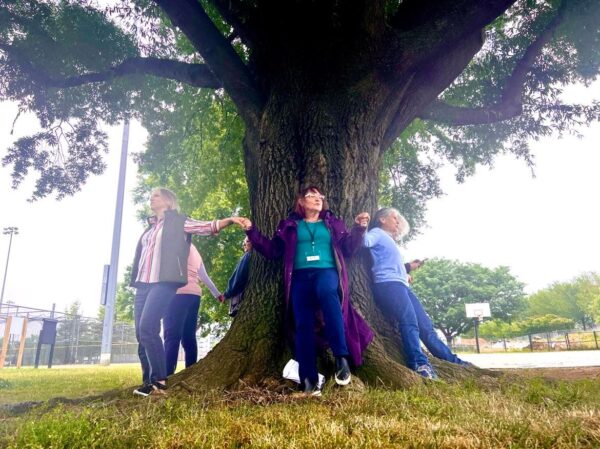
A number of Del Ray residents locked arms around an oak tree slated for removal at Eugene Simpson Stadium Park in Del Ray on Wednesday, only days after City Council approved a plan to renovate the park.
Gisele McAuliffe, a 30-year Del Ray resident, says that the city’s approved plan to renovate the park will come at too great a cost — the removal of 40 trees. The age of the trees is in dispute, as the city says the oldest trees on the property were planted in the 1940s, while McAuliffe and her friends measured the trees and claim they are upward of 100 years old.
“The reason for tearing down these beautiful trees is that they want to expand parking and put in bleachers,” McAuliffe said. “A park that has to accommodate cars when there’s plenty of street parking and other parking in the area just doesn’t make sense.”
The approved plan calls for the removal of 41 trees around the 16-acre property to make way for an expanded parking lot, new lighting and pedestrian improvements. The city says that there is no chance for the trees slated for removal to be saved.
“To mitigate the 41 trees being removed, the City is planting of 110 native trees and over 350 shrubs,” Jack Browand, the city’s deputy director of Parks Services. “The design doubles the total tree canopy currently in the park.”
The land for Simpson Park was donated to the city in the 1940s and the two baseball fields at the park were built in 1953.
“The City has not identified a tree that is reportedly 150 years old,” Browand said. “Historical area photos show at least back to the late 40s, the site was primarily open space with an informal baseball field.”
The new trees, combined with the trees that will be preserved, will provide 25.3% crown coverage within the site area, meeting the 25% minimum requirement and doubling the amount of 12% of crown coverage that exists today, according to the city.
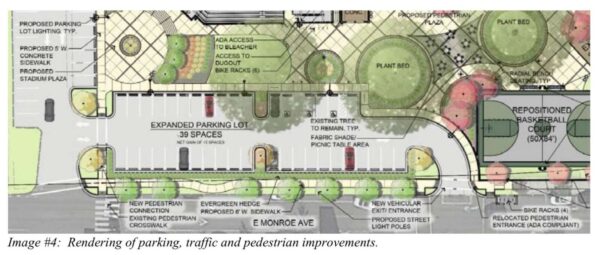
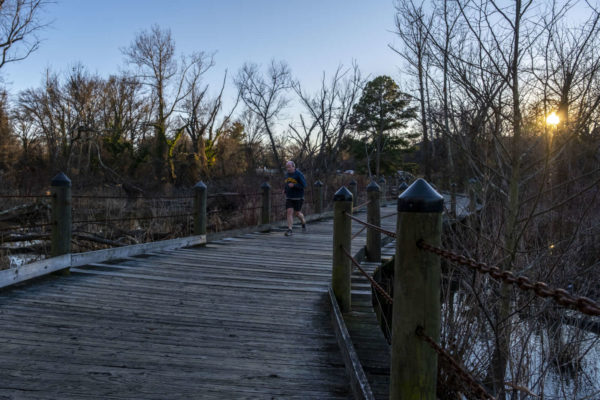
The Friends of the Mount Vernon Trail have done a lot of work on the eponymous trail, and now the group is offering a unique new way of experiencing it.
The group is hosting a “Fireflies and Bats Walk” on Saturday, June 24, from 8:45-9:45 p.m. The tour is free but attendees can get tickets and make an optional $10 donation online. The tour starts at 615 Slaters Lane.
“How do fireflies produce their glow?” the event listing asked. “Why are bats an important part of the ecosystem? Come find out on our firefly and bat walk. We’ll meet at the corner of Abingdon and Slaters Lane outside of the Salvation Army Headquarters.”
The tour includes a visit to some of the best bat and firefly watching spots along the trail and a look at a device used to identify different species of bats based on the frequency of their echolocation.
The walk is about one mile long.
Guests should bring a reflective vest and a flashlight — ideally one with a red light setting.
Experience the Mount Vernon Trail at night. Join us for a short walk on the MVT while we show you our favorite locations for bat and firefly watching. This is a kid friendly event!
🦇 : 8:45 pm
🦇 Sat June 24
Register: https://t.co/lVjVJKpDRp pic.twitter.com/IfX77UQdRJ— Friends of the Mount Vernon Trail (@MtVernonFriends) June 21, 2023
H/t to Sloane Airey

Alexandria’s drinking water has an “actionable” level of Polyfluoroalkyl Substances (PFAS), and the City Council just endorsed a plan to help clean it up.
The long-lasting substances, also known as “forever chemicals,” are hard to break down and pollute Alexandria’s drinking water to an “actionable” degree, Mayor Justin Wilson wrote in a letter unanimously supported by Council. PFAS are proven to weaken immune response, increase cancer risk and liver damage, and pose a risk to pregnant women and their babies.
“This is not a new issue that has been raised to our our attention,” Wilson said on Tuesday night (April 25). “Alexandria’s drinking water has a relatively high action levels in a couple of different areas.”
In February, the U.S. Environmental Protection Agency announced that $27.2 million from President Joe Biden’s Bipartisan Infrastructure Law would go to Virginia to address “emerging contaminants” in drinking water. The manufactured chemicals are known as Per- and Polyfluoroalkyl Substances (PFAS), and include industrial and consumer products such as cosmetics, shampoo, certain dental flosses, cleaning products, fire extinguisher fluid, food containers and non-stick cookware.
On March 29, EPA proposed new maximum contaminant level (MCL) goals by targeting a number of PFAS. The proposal was published in the Federal Register and must undergo a 60-to-90 day public comment period.
Wilson urged the EPA to finalize the regulations without delay, and the agency anticipates doing so by the end of the year.
“Alexandria’s waterworks is one of the thousands of systems nationally that currently exceed the MCL (maximum contaminant level) that the EPA has proposed,” he wrote. As detailed by the EPA’s analysis, full implementation of these new standards will prevent tens of thousands of illnesses and deaths.”
Alexandria residents get their water from Virginia American Water Company, which reported last year that the city’s PFAS are actionable under EPAs proposed regulations.
- Perfluorooctanoic Acid (PFOA): Range detected 2.8 — 4.5/ppt (parts per trillion)
- Perfluorooctanesulfonic Acid (PFOS): Range detected 3.2 — 4.0/ppt
- Perfluorohexanesulfonate (PhHxS): Range detected 0.0 — 2.3/ppt
- Perfluorobutanesulfonic Acid (PFBS): Renge detected 0.0 — 4.7/ppt
The Virginia Department of Health is also advising that public water systems detecting PFAS in drinking water should “take steps to inform customers, undertake additional sampling to assess the level, scope, and source of contamination, and examine steps to limit exposure.”
Boosted by multi-million dollar endowment, ownership of the 45-acre Winkler Botanical Preserve (5400 Roanoke Avenue) was signed over to NOVA Parks on Thursday (September 15).
Mayor Justin Wilson was joined by members of City Council, interim Alexandria City Public Schools Superintendent Melanie Kay-Wyatt, City Manager Jim Parajon and city staff for the deed signing ceremony.
“This is a beautiful property,” Wilson said. “The fact that we are making this handoff happen here tonight, and in bringing NOVA Parks as the custodian of this property for the next generation is so exciting.”
The Winkler Botanical Preserve was created in 1979 by environmentalist Catherine Winkler Herman, who established it as a natural space for generations to enjoy in perpetuity.
The Winkler Organization gave NOVA Parks a $1 million check for capital needs at the deed-signing event, and will give a $3 million operating endowment for educational programs and other improvements.
“The steadfastness of the Winkler’s generosity over generations and their ability to see beyond the horizon is both humbling as it is inspiring,” said Cate Magennis Wyatt, chair of the NOVA Parks board of directors.
Randall Kell, president of the board of the Winkler Botanical Preserve for 30 years, said that the deal with NOVA Parks is a “match made in heaven.”
“How wonderful it is to have such an experiences, successful organization such as NOVA Parks, which shares so many of the values, goals, aspirations and ambitions that the Preserve has had for more than 50 years, step up to lead the Preserve for future generations.”
Kay-Wyatt said that the Preserve will be a valuable educational resource for Alexandria students.
“When you have an opportunity and a gift like this for children to come outside of that traditional classroom and to experience nature’s classroom, it is a gift to us all as educators,” Kay-Wyatt said.
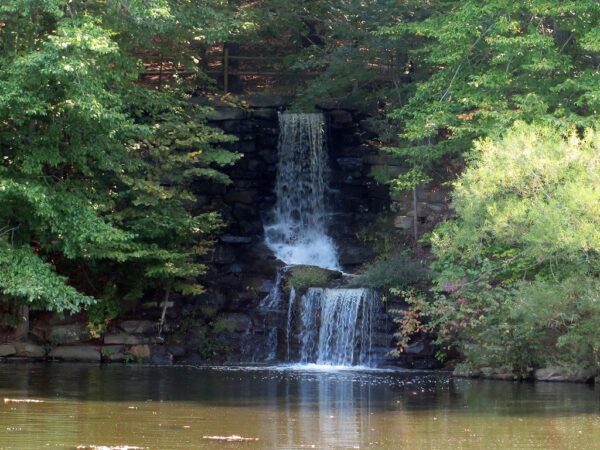
The Winkler Botanical Preserve (5400 Roanoke Avenue) has been a tucked away, isolated enclave of natural beauty not far from the Mark Center, but with a new acquisition it could be thrust into the limelight.
Regional parks organization Northern Virginia Regional Parks Authority (NOVA Parks) announced today that it will take over ownership of the 44.6 acre nature preserve.
The Winkler Botanical Preserve was created in 1979 and features streams, a pond, a waterfall, and trails. The goal of the preserve was to create an island of natural beauty in the rapidly urbanizing city. The preserve was established by Catherine Winkler Herman, a philanthropist and environmentalist, in honor of her late husband: real estate developer Mark Winkler.
“The enormity of this gift cannot be overstated,” Cate Magennis Wyatt, NOVA Parks’ chair, said in the release. “Catherine Winkler Herman’s vision and Tori Winkler’s brilliance have created an unparalleled botanical oasis within our highly urbanized Northern Virginia. NOVA Parks is honored to be the new stewards of the Winkler Botanical Preserve and on behalf of the generations to come, express our eternal gratitude to the Winkler family.”
In a poll last year, 56% of ALXnow readers said they’d never heard of the park until recently. That’s likely to change, though, with NOVA Parks — which also runs Cameron Run Regional Park — overseeing a significant investment in the park.
NOVA Parks said that, as part of the transfer, the Winkler Organization will provide NOVA Parks with $1 million for capital needs and a $3 million operating endowment to support educational programs and improvements at the preserve.
“In addition, the Winkler Organization is gifting the City of Alexandria with $1 million to advance community engagement and learning resources for City residents and visitors of the Preserve,” NOVA Parks said.
The Winkler Organization will be making an additional $100,000 grant to ALIVE!, a local nonprofit dedicated to fighting poverty and hunger, specifically to supply food and basic needs to families in neighborhoods close to the preserve.
A ceremony later this week will officially mark the transfer. Due to limited on-site parking, parking will be available at William Ramsay Elementary School (5700 Sanger Avenue) with vans shuttling attendees to the site.
“On Thursday, September 15 at 6:30 p.m., NOVA Parks will host a ceremony with representatives from the Winkler Botanical Preserve (Winkler Organization) and local leaders including City of Alexandria Mayor Justin M. Wilson,” NOVA Parks said in a release. “Located in Alexandria’s West End, the Preserve provides public access to nature and protects plants native to the Potomac region.”
“A generation of Alexandria youth, including both of my children, have enjoyed the outdoors at the Winkler Botanical Preserve,” Mayor Justin Wilson said in the release. “With the funds the City is receiving to help our school-age children go to the Preserve and the renewed programming that NOVA Parks will bring to the site, a new generation will be enriched in this wonderful place. We are profoundly grateful for the generosity of the Winkler Organization to ensure the accessibility of this natural space for generations to come.”
Photo via NOVA Parks/Facebook
Over a year after City Council paused its controversial stream rehabilitation projects, the City of Alexandria is hosting community meetings next week to restart that process.
The City Council paused stream rehabilitation projects for Taylor Run and Strawberry Run after local civic and environmental activists argued the projects could end up damaging the quality of the streams they were trying to help. City staff reviewed the concerns and said many were unfounded, but the debate raised sufficient uncertainty that the City Council sent the projects back to the drawing board for review.
One of the main criticisms of the city’s projects was that there was no water quality testing in the streams. The project was based on state models, and environmental activists estimated the model’s numbers were different from the actual situation on the ground.
In a newsletter, Mayor Justin Wilson said those activists were correct:
The measurements were conducted and were received by the City and our Environmental Policy Commission at the end of last year. These measurements show that the default formula provided by the Commonwealth’s Department of Environmental Quality (DEQ) to estimate pollutant reductions, over-estimates the pollutant reduction for these three projects, as expected. In the case of Taylor Run, our estimated pollutant reduction rate of $15,000 per pound, will rise to $50,000 per pound. For Lucky Run, it goes from $7,000 per pound to $72,000 and for Strawberry Run it goes from $5,000 to $20,000. If the City seeks to claim to obtain the same pollution credits, using this method, it will now cost more.
Now, a city release said the public is invited to a “consensus-building workshop” to discuss alternative approaches for the stream projects.
“The workshop will be held at Alexandria Renew Education Center & Meeting Space, 1800 Limerick Street on Saturday, Sept. 10 from 8:30 a.m. to 2:30 p.m. and a hybrid option is also available via Zoom link,” the city said in a release. “The workshop format will include presentations in the morning on the different alternatives, a lunch break and breakout discussions around community goals on improving the two streams.”
The workshop will be led by the Institute for Engagement and Negotiation (IEN) at the University of Virginia and co-hosted by the City of Alexandria’s Transportation and Environmental Services, Stormwater Management Division, and the Department of Project Implementation.
The release said the workshop will give the public a space to weigh in on the project.
“This workshop and subsequent meetings are an opportunity for stakeholders to provide feedback and comments on alternative approaches to restore and improve the health of the streams,” the release said. “It’s one of the multiple workshops set up with the goal of reaching a consensus. “
A report prepared by IEN is scheduled to be presented to the City Council in December.
Wilson said the city brought in IEN to serve as a neutral third party to help facilitate further discussion.
“The City has important obligations to improve the quality of the water in the waterways of our region,” Wilson wrote. “These investments are intended to maintain our commitment to the future of the Chesapeake Bay and address human-caused damage in these natural areas. We will continue to work to determine the best approach as we move forward.”
The City of Alexandria is hosting a community workshop this Saturday (Aug. 27) that will let locals weigh in on the city’s plans to fight climate change.
The meeting at the Durant Memorial Center (1605 Cameron Street) is the third and final meeting in a series that aims to review the city’s progress towards its goals of combatting climate change on a local level and plan future efforts.
“The Community Workshop will provide you with the opportunity to provide feedback on new and ongoing actions to help reduce climate change causing greenhouse gas emissions from buildings, transportation, the electrical grid, and other sources,” the city said on its website. “The Community Workshop will also provide you with the opportunity to comment on actions the City may take to help reduce the impacts from climate change.”
The meeting is part of a process to update the Environmental Action Plan approved in 2019. That plan establishes a target of 50% reduction in greenhouse gas emissions by FY 2030, with escalating goals in the following years
“The EAP2040’s targets include reducing community-wide greenhouse gas emissions by 50% by 2030 and 80 to 100% by 2050, supported by significant state and federal contributions,” the website says. “The City’s update of the Energy and Climate Change Action Plan will leverage regional priority actions identified in the Metropolitan Washington Council of Governments (MWCOG) 2030 Climate and Energy Action Plan, as well as the climate action planning efforts underway or completed by the City’s regional and national peers.”
SATURDAY: Join our community workshop that focuses on updating the Energy and Climate Change Action Plan (ECCAP). Learn about climate change issues affecting our community and share your ideas on how the City can adapt and be resilient.
More info at https://t.co/3vgjVteSt1. pic.twitter.com/QTbSL1i1Qc
— Alexandria Transportation & Environmental Services (@AlexandriaVATES) August 22, 2022


